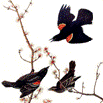Center, Internet, Wildlife Damage Management

Bird Control Seminars Proceedings
Document Type
Article
Date of this Version
October 1973
Abstract
In the early 1960's, Sand Lake National Wildlife Refuge, Brown County, South Dakota, served as an assembling area for the largest late summer blackbird congregation known to us in the Norhtern Great Plains or the western portion of the Cornbelt. Approximately 4,000 acres of cattail (Typha) and reed (Phragmites) at the Refuge served as ideal roosting habitat for blackbirds. In August and September each year, postbreeding flocks of blackbirds from northern South Dakota, North Dakota, and Canada assembled to molt in these marshes and to feed on the abundant blackbird foods in the surrounding agricultural lands before migrating to wintering areas in the southern United States and Mexico. Most of these foods were provided by large acreages of ripening corn, oat stubblefields, and cut-over haylands, all of which also contained a variety of weed seeds, especially pigeon grass (setaria), a preferred Redwing food (Mott et al.,1972). Ripening cornfields adjacent to the Refuge marshes frequently lost from 5 to 25 bushels per acre to blackbirds in the early 1960's. During that period, we began intensive studies in the area, testing most of the methods already in use for protecting cornfields from blackbirds, along with many other methods that had indicated potential when used for other problems (De Grazio, 1964). However, we achieved substantial protection on only a few fields until we began using a chemical frightening agent, 4-aminopyridine (4AP), on large acreages in 1964. Beginning at that time, both the Sand Lake blackbird population and the damage they caused to ripening corn began to decline. In this paper, we discuss this decline and its probable cause.

